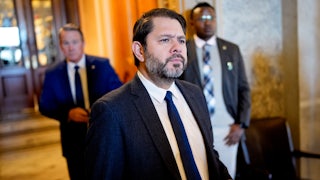This week, as the ongoing crisis in Ukraine and the Supreme Court confirmation hearings have consumed most of the media’s attention, another story has flown under the radar: that of the dire condition of childcare. During a Tuesday hearing held by the Senate Committee on Health, Education, Labor, and Pensions, or HELP Committee, experts sounded the alarm about the state of the childcare industry two years after the Covid-19 pandemic completely upended it.
During the pandemic, the American Rescue Plan Act, or ARPA, has provided the childcare industry with vital funding backstops. But much of that funding is set to expire in September 2023, with the rest closing up the following year. With the clock ticking, industry leaders like Ellen Reynolds, the CEO of the Georgia Child Care Association, who testified at this week’s hearing, have grown increasingly concerned about the treacherous landscape ahead. “Without further investments, the country will face a catastrophic decline in access to childcare, as providers will no longer be able to pay teachers competitive rates, nor provide tuition relief for families,” she told the committee. We may not have to wait until next year for this crisis to manifest itself. As Axios’s Emily Peck noted on Twitter, the consequences of this fiscal cliff are imminent: “Operators already can’t pay workers enough,” she wrote.
The ARPA intervention was critical for children and did a lot of immediate good. As Chabeli Carrazana reported in early March for The 19th, the $39 billion that the ARPA distributed to states and providers was “the largest child care allocation ever in U.S. history and more than the federal government spent on the industry in the previous five years combined.” The beneficiaries of that funding described it to Carrazana as “tide turning,” critical to maintaining decent wages and benefits for staffers and helping organizations to “navigate the unknown.”
But as this critical support ebbs, the future gets murkier. As Carrazana noted, “The problems in the child care industry are substantial and structural. Parents pay a significant amount of their income for care, but centers are barely able to bring in enough money to pay their staff above minimum wage.” Lauren Hogan, the managing director for policy and professional advancement at the National Association for the Education of Young Children, told The 19th that if the funding stops, “everything we predicted in the early days of the pandemic around the collapse and mass closure of programs” will come to pass.
Reynolds recommended that the Senate HELP Committee allocate an additional $400 billion this year to shore up the industry’s vulnerabilities and build upon improvements. But, importantly, she wants the funding to “be provided in the reconciliation process because we do not believe Congress will allocate enough funding to make a material difference in access to child care through the traditional budget process,” she said. Reynolds is, of course, referring to the fact that the filibuster currently prevents the Senate from moving anything forward through the normal legislative process; only through the budget reconciliation process can anything pass with a simple majority. Understandably, she doesn’t trust Congress to do what’s right through conventional lawmaking.
But if only it were so easy. Right now, there aren’t even enough Democrats willing to push anything through reconciliation, either. If they could, the $400 billion that was bundled up in the Build Back Better Act for childcare and preschool would already be on its way out the door to those who need it the most. Moreover, Democrats also failed to extend the expanded child tax credit, another critical tool that offered parents a financial cushion during the pandemic, as Grace Segers wrote for TNR in January.
The child tax credit’s demise has also pushed more children toward the cliff. As The Washington Post’s economics reporter Jeff Stein summarized this week, the failure to extend the expanded child tax credit means that nearly four million children have been “thrust back into poverty,” the child poverty rate is back up by nearly 41 percent, and the discussion of these matters has “totally disappeared from DC discourse.” Also absent from the discourse: the fact that Congress failed to extend funding for pandemic-era child nutrition waivers, which will result in millions of needy kids missing out on school meals.
The United States has long lagged woefully behind our peer countries when it comes to providing for the next generation. But the disarray of recent months has been particularly galling. As I’ve previously noted, it’s truly appalling that lawmakers acted on the impetus the pandemic provided to earn major victories against child poverty, only to allow them to lapse and erase these hard-won gains.
But these are fruits of the inaction and ineptitude that bogged down the Biden agenda throughout the tail end of last year, and which are preventing Democrats from delivering on a legislative majority that’s quickly shifting from tenuous to temporary. Politicians and pundits will spend a good many months arguing over what could have been done differently and who specifically is to blame for the fact that so many opportunities to improve people’s lives were pissed away. But children and their parents are being pushed ever closer to the brink, and the voters will have their say about it in November.
This article first appeared in Power Mad, a weekly TNR newsletter authored by deputy editor Jason Linkins. Sign up here.










